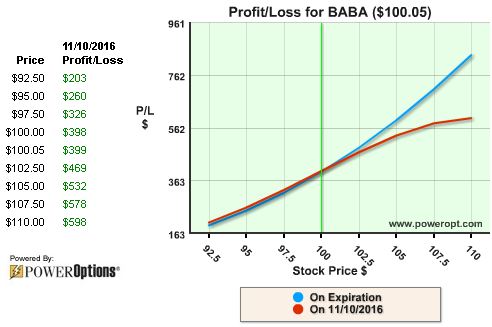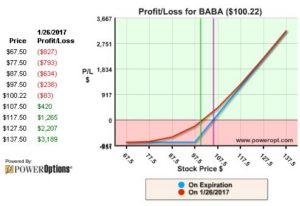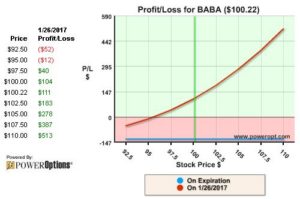Heya Traders! In today’s post I’ll show you how one of our traders was able to bulletproof stock in three trades!
Earnings: Rolling the Dice with High Stakes
It’s November 1 as I write this post.
Tomorrow, AliBaba (BABA) reports earnings.
The news could CRUSH investors… or it may give them a serious boost.
For RadioActive Trader Greg Zerenner, earnings is no big shakes; he will make money no matter which way the winds of fortune blow.

BULLETPROOF!
It’s easier than you think to remove the risk in a stock position, but let it ride higher
Because Greg used the RadioActive Setup as a context for trading as many as twelve “Income Methods”… reducing the cost basis of his married put to the point that it’s lower than the strike price of his put.
That means “heads you win, tails you can’t lose.”
WOW.
Check the deets, yo:
The “RadioActive Profit Machine” Low-Risk Trading Setup
Okay let’s track this, shall we?
FIRST TRADE: Buy an uniquely arranged married put.
Greg began his RPM, or RadioActive Profit Machine August 23rd this year with 100 shares of AliBaba (BABA) at $96.38.
At the same time, he also picked up an April 2017 $97.50 put option for $9.30… an IN-the-money put option with a far expiration. This gave him three things:
- A very safe, single-digit risk investment in case the stock took a dump
- Unlimited upside in case the stock went skyward
- As long as eight months to use the proprietary RadioActive Trading ‘Income Methods’. Get good information on trading here.

BABA RadioActive Profit Machine (RPM) Setup. Even at the beginning he only risked single-digit percents (7.7%)
His position began with only 7.7% of his capital AT RISK… but that wasn’t going to be the case for long.
Capturing Premium “Upside Down” to Reduce Risk Further
Second Trade: In response to the market’s move, swap a cheap put for a more expensive one.
The next thing that happened with BABA was that it exceeded the $97.50 price point. In the RadioActive Trading Blueprint, for cautious traders that’s an indication to take premium upside down.
“Whaaaaaa…?” you might be saying. “How on Earth do you capture premium upside down?
Simple. BABA went up, which meant that the April $97.50 put option’s value went down. On September 27, Greg sold that April $97.50 put for $6.30… and in its place he bought an April $110 put for $11.90.
Let’s keep it simple and visual:
“Income Method Four”. Swapping the $97.50 put for a $110 put costs $5.60, but RAISES the minimum payout by $12.50. Nice.
On the surface, it looks a lot like Greg “lost” $300. After all, the first put was bought for $9.30 and sold for $6.30.
Ahhh, but the second put was made cheaper too. Plus, the first put still had a lot of the value it started with.
So that when he cashed in the first put, it was sooooper cheap.
So what does “capturing premium upside down” mean?
Lookit: Greg spends $5.60 ($11.90 for the higher put, minus $6.30 for the lower one)…
…but he gets to adjust the guaranteed sell price of the stock from $97.50 to $110!
Spending $5.60 to get a $12.50 return. That’s good business.
Here’s the new risk picture of Greg’s stock plus long-term-in-the-money-put:
Eliminate ALL Risk… Make it BULLETPROOF
Third Trade: In the context of all this, sell a covered call.
And now we almost get lazy. Those of you that are familiar with the use of covered calls, take note: Instead buying stock close to earnings, and immediately capturing a tiny premium, you risk MOST of your capital on volatile stocks.
But Greg… not so much.
By now Greg has an instrument that can’t get him in trouble, no matter how low the stock may go post-earnings. But he CAN grab inflated premium just before earnings with no worries because of his setup and the adjustments so far. On October 29 he snatched $1.64 by selling the November $110 call. There are some reliable trading platform that one can trust in such decisions.
Last nail in the coffin: there is now NO risk as the cost basis for the stock plus put is LESS than the strike price of the put.
This little bit of premium normally would provide less than 2% hedge in case of stock going down in a “plain-vanilla” covered call trade. But his case, Greg has eliminated the last vestiges of risk at all, while at the same time securing the chance for as much as a 7.6% payday.
Behold:

No risk, no mas. Worst case scenario is a payout that handles commissions to date; best case is a healthy profit
Now that there is ZERO risk, Greg will have a restful night’s sleep. Jealous? 😉
What’s Next for this Bulletproof Position?
Well, one thing is for certain. Greg can’t lose, even on the eve of this precipitous news event.
If BABA takes a total DUMP and goes to $50 a share… Greg gets to cash in his chips and have no risk.
But on the other hand, say BABA goes to $107 after earnings and thru expiration. Greg has no obligation to deliver his shares after that… but he MAY decide to use one or more of the other ten Income Methods to milk his BABA RPM for more premium.
Hey, this bulletproofing thang isn’t like a UFO or a unicorn. We see this stuff all the time.
For example, Greg’s buddy Mike is sitting on a position now that’s bulletproof to the tune of over -10% risk. That is, ten percent negative risk.
Because his Footlocker (FL) stock cannot fail to deliver him less than 10% profits.
Oh, Mike gets to grab dividends too.
How about YOU, dear reader? 🙂
Would YOU like to learn to become Bulletproof in earnings season?
Put your comments below. I’ll send you a cheat sheet on how to bulletproof your stocks.
Better yet, join the mailing list and you’ll get a free gift on me.
Happy Trading,
Kurt


 I'm Kurt Frankenberg, and I have discovered how to truly put the odds on the side on the individual investor.
I'm Kurt Frankenberg, and I have discovered how to truly put the odds on the side on the individual investor.
You spent a total of $14.90 for the 110 put.
I think his math is not accurate. There is not bulletproof here..
Thanks for the very interesting method of bulletproofing a stock purchase. Please send cheat sheet for duplicating this method for real trading.
Much appreciated
Rob
Thank you… Very good information.
Thanks for the info.! Please snd a cheat sheet.
What you SPENT when you bought the dearer put was $5.60 but, surely, what it COST you to reach that position was $8.60. Still a good price for a $12.50 return but not nearly as good a return.
Ian
yep, your math is wrong Kurt, he lost 3 on his first put and spent 5.60 on the second purchase =8.60 cost.
Did not disclose the price of BABA on the day the swap occurred.
Hi Mike: BABA was at $107.48 when the first IM was performed. Then $103.80 when the next IM was performed.
Kurt…I like this system very much. It seems to be very capital intensive tho. Will this work as well replacing the actual stock with a long option, possibly a leap? or is the bid/ask spread too much to overcome on the leap? Thank You – Jimmy
Kurt…I have a question about the trade simulator tool… Would I get the same results on the tool if I doubled the amount invested to 20,000 but cut the amount of trades in half to 50? or $40,000 invested in only 25 trades? Thanks again…..Jimmy
good info, looking forward for the cheat sheet
Since this is a bullish strategy, will it also work well with less volatile stocks like high dividend companies? Please also send the cheat sheet. Thanks!
Arithmetic Errors here hide the fact that this is a losing trade, after brokerage fees, unless the price goes above 110 a share.
First Put bought and closed out and sold for a loss of $3.00.
(That there were proceeds of $6.30 means nothing: in relation to the 9.30 original outlay, you get the $3.00 loss, the cost of getting into and out of that put.)
Second, new put bought for 11.90.
(We don’t care about the 6.30 at this point, we care about the 3.00 loss.)
So far the put trades have cost $14.90 for all of the puts (3.00 + 11.90), the first of which was closed out at a loss.
The stock was bought for 96.38 for 100 shares
Total cost $9,638 stock + $1,490 for the two puts = $11,028 total cost
Minimum payout is at strike price of 110 or $11,000,
making for a LOSS of $28,
if the price is less than 11,028, all this before broker fees.
The 107 hypothetical price mentioned is still a losing price,
but not much of a losing price, with a loss of $28.
Selling the near date-to-expire call for November at $110 earns just enough money to finally better break even, if you ignore brokerage fees. Proceeds of $1.64 for $164.
Now the net cost of the trade is $11,028, less the November call proceeds of $164, for cost of trade $10,964.
The new break even price is 109.64 a share.
Finally, the trader, at this point would make $36, before brokerage fees, if the stock tanks, or if the November call takes the stock away.
By the time of the third option trade, the November call, the position has become riskless, but also there is no profit in it, until the price goes above 110. But the the short call might have taken the stock away by that time.
Hello Mark,
The trade was profitable and closed for a gain of 1.2% ($129 profit of an end investment of $109.64). When the position was closed, BABA was trading at $102.93, or -$6.71 (-6.12%) from the adjusted cost basis. After commissions, the position was still at a gain of 1%. Not great, but not a loss from the initial cost basis or the adjusted cost basis.
The BABA position was closed on March 2nd, 2017 (when the stock was trading at $102.93). The earnings release was around JAN 25th, 2017 (and Greg was still holding the April put). The stock moved up to $104.06 on JAN 25th, 2017. Since it was an April 110 put and had 3 months of time value remaining, the position could have been liquidated for a higher profit:
1/25/2017: Sell to close BABA at $104.06, Sell to Close April 110 put at $8.20. Liquidation value = $112.26. Gain = $112.26 – $109.64 = $2.62, or gain of 2.4%.
In January it was Greg’s thoughts that BABA would continue to rise and move back to $110 where other adjustments would be made over the next few months, prior to April expiration. However, that did not happen and he closed in March for the small profit. Other adjustments could have been made during that time, but would have countered Greg’s CEGA model for the position. The CEGA model is described in The Blueprint for each of the 12 income methods or adjustments we use against the initial low risk position.
IF Greg held the position all the way to April 2017 expiration, you are correct. All of the time value would have moved out of the put, and unless it was trading at $110 (really, higher) no more than $36.00 would be made. That was not the plan, and things may have not gone exactly as Greg had planned, but the trade was still profitable even though it was closed when BABA was at $102.93. BABA did close at $113.00 on April expiration, so the profit would have been around $3.36.
Thank you for the comment, and I am sorry it took me so long to get back to you (we had a problem with the blog notifications and I did not see your post until last week).